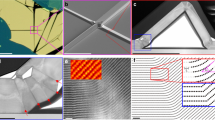Abstract
The investigation reported here extends the conventional approach to the study of the interface network, by consideration of Σ3n values up to n = 7 in alpha-brass. All 24 crystallographically-related solutions for each Σ3n misorientation are included. The study has shown that multiple annealing twinning does not result in aggregation of higher Σ3n values and concomitant reduction in Σ3s. When a 5° deviation from the exact reference misorientation was used, 20% and 27% of the interface length was Σ729 and Σ2187 respectively. This is a consequence of the increasing number of Σ3n variants as n increases. Interactions of Σ3n, often Σ3 + Σ3n↔Σ3n +1, were observed frequently in the microstructure. The prevalence of boundaries near to high order Σ3n attests their importance in the evolution of microstructure. Analysis of all 24 equivalent solutions for Σ3n boundaries has shown that approximately half of these are misoriented on \(\langle 110\rangle\), compared to less than one-third on \(\langle 111\rangle\). The promulgation of Σ3n boundaries via multiple twinning interaction events promotes and increases the proportion of \(\langle 110\rangle\) tilt boundaries, and to a lesser extent \(\langle 111\rangle\) boundaries. These misorientations have been shown to be associated with low-index boundary planes, and therefore multiple twinning is instrumental in promoting these ‘special’ planes.
Similar content being viewed by others
References
V. RANDLE, Acta Mater. 52 (2004) 4067.
V. Y. GERTSMAN and C. H . HENAGER, Inter. Sci. 11 (2003) 403.
V. RANDLE, Acta Mater. 47 (1999) 4187.
G. GOTTSTEIN, Acta Metall. 32 (1984) 1117.
V. Y. GERTSMAN, in Science and Technology of Interfaces, edited by S. Ankem, C. S. Pande, I. Ovid’ko and S. Ranganathan (TMS, 2002) p. 387.
V. RANDLE, Scripta Mater (in press).
V. RANDLE and H. M. DAVIES, Mater. Trans. A 33 (2002) 1853.
D. G. BRANDON, Acta Metall. 14 (1966) 1479.
C. KIM, Y. HU, G. ROHRER and V. RANDLE, Scripta Mater. 52 (2005) 633.
D. M. SAYLOR, B. S. EL-DASHER, A. D. ROLLETT and G. S. ROHRER, Acta Mater. 52 (2004) 3649.
K. L. MERKLE and D. WOLF, Philos. Mag. A 65 (1992) 513.
U. WOLF, F. ERNST, T. MUSCHIK, M. W. FINNIS and H. F. FISCHMEISTER, ibid. 66 (1992) 991.
V. Y. GERTSMAN and S. M. BRUEMMER, Acta Metall. Mater. 42 (1994) 1785.
Author information
Authors and Affiliations
Rights and permissions
About this article
Cite this article
Randle, V. The effect of twinning interactions up to the seventh generation on the evolution of microstructure. J Mater Sci 41, 653–660 (2006). https://doi.org/10.1007/s10853-006-6481-3
Issue Date:
DOI: https://doi.org/10.1007/s10853-006-6481-3




